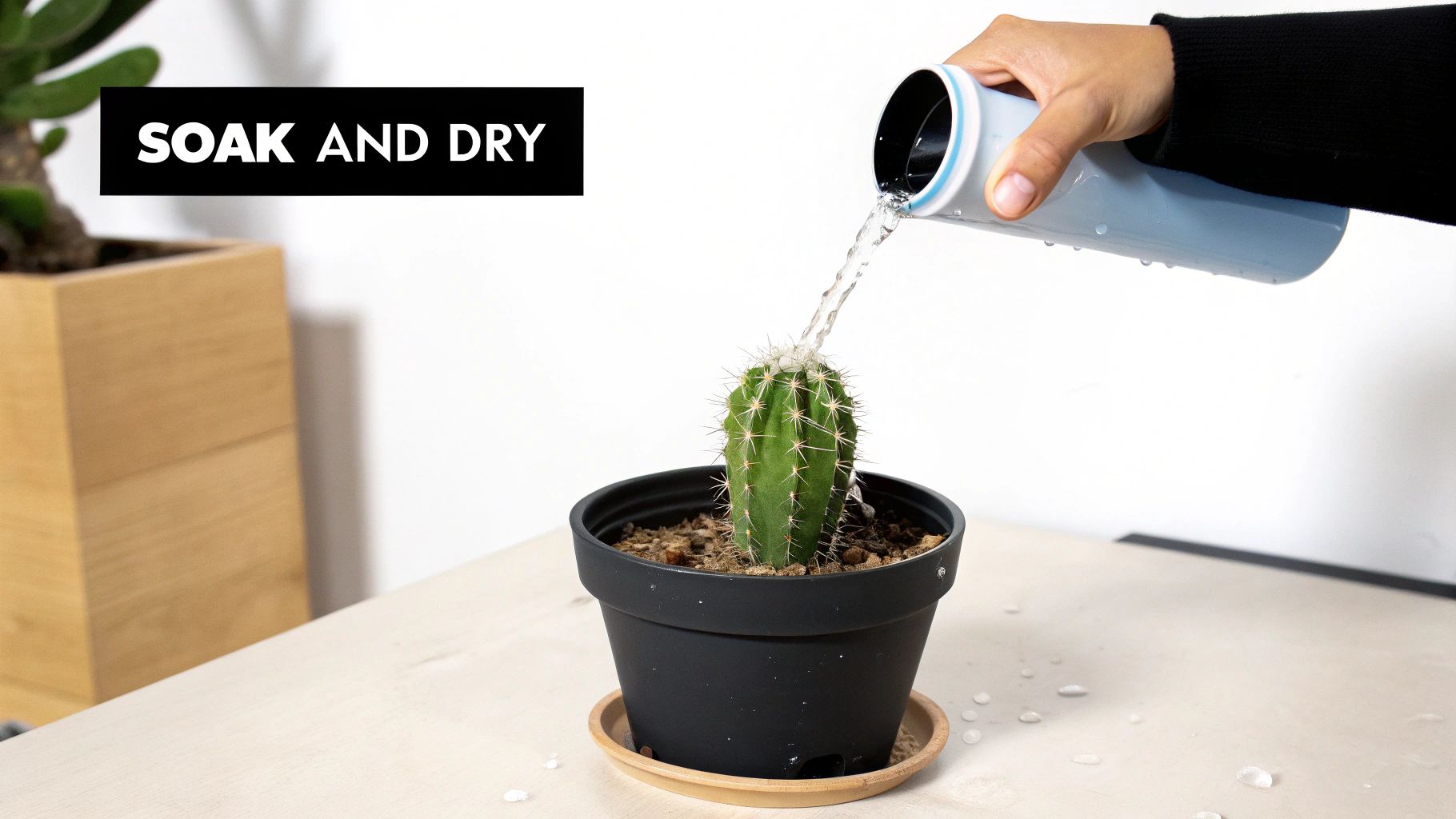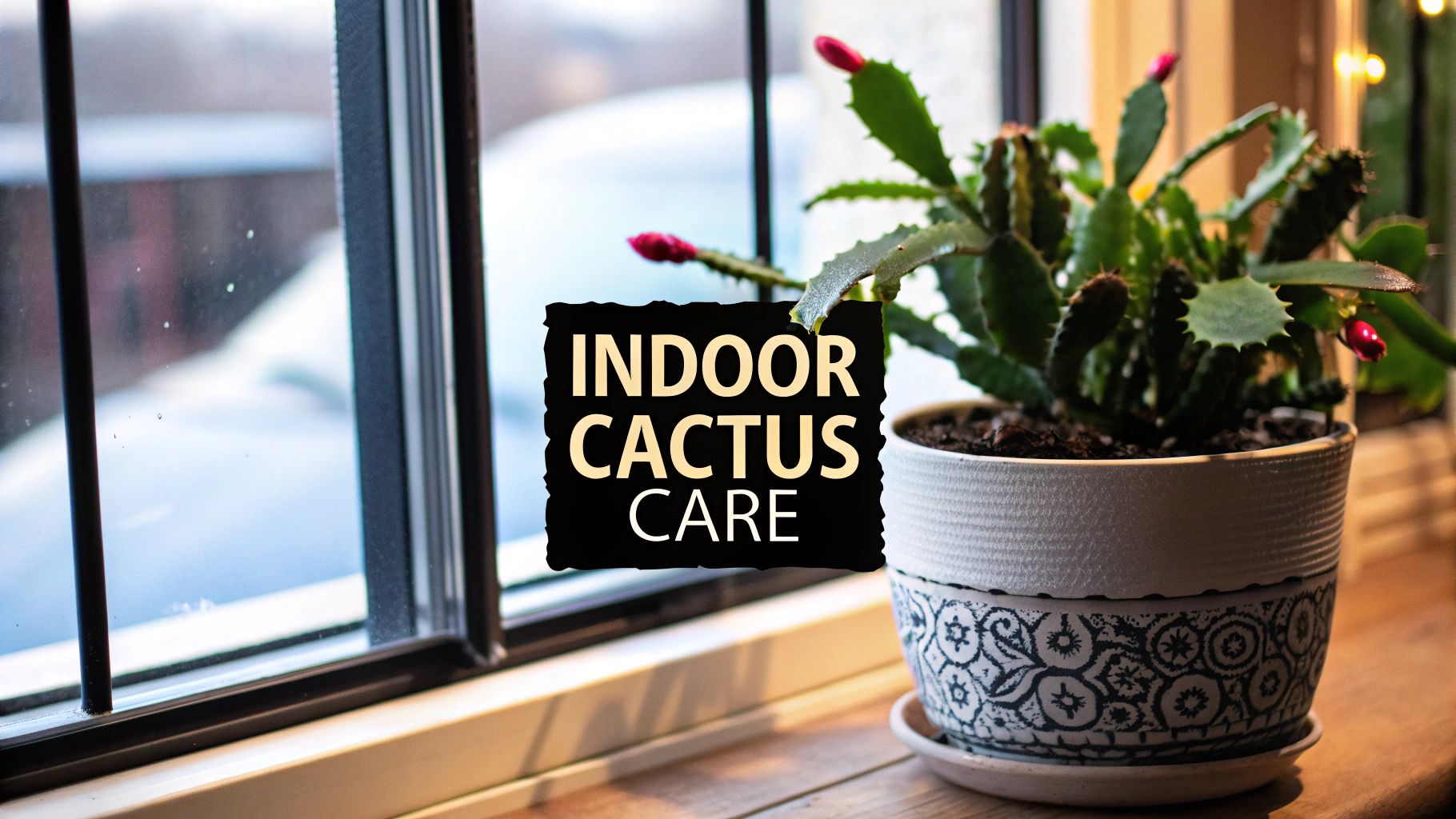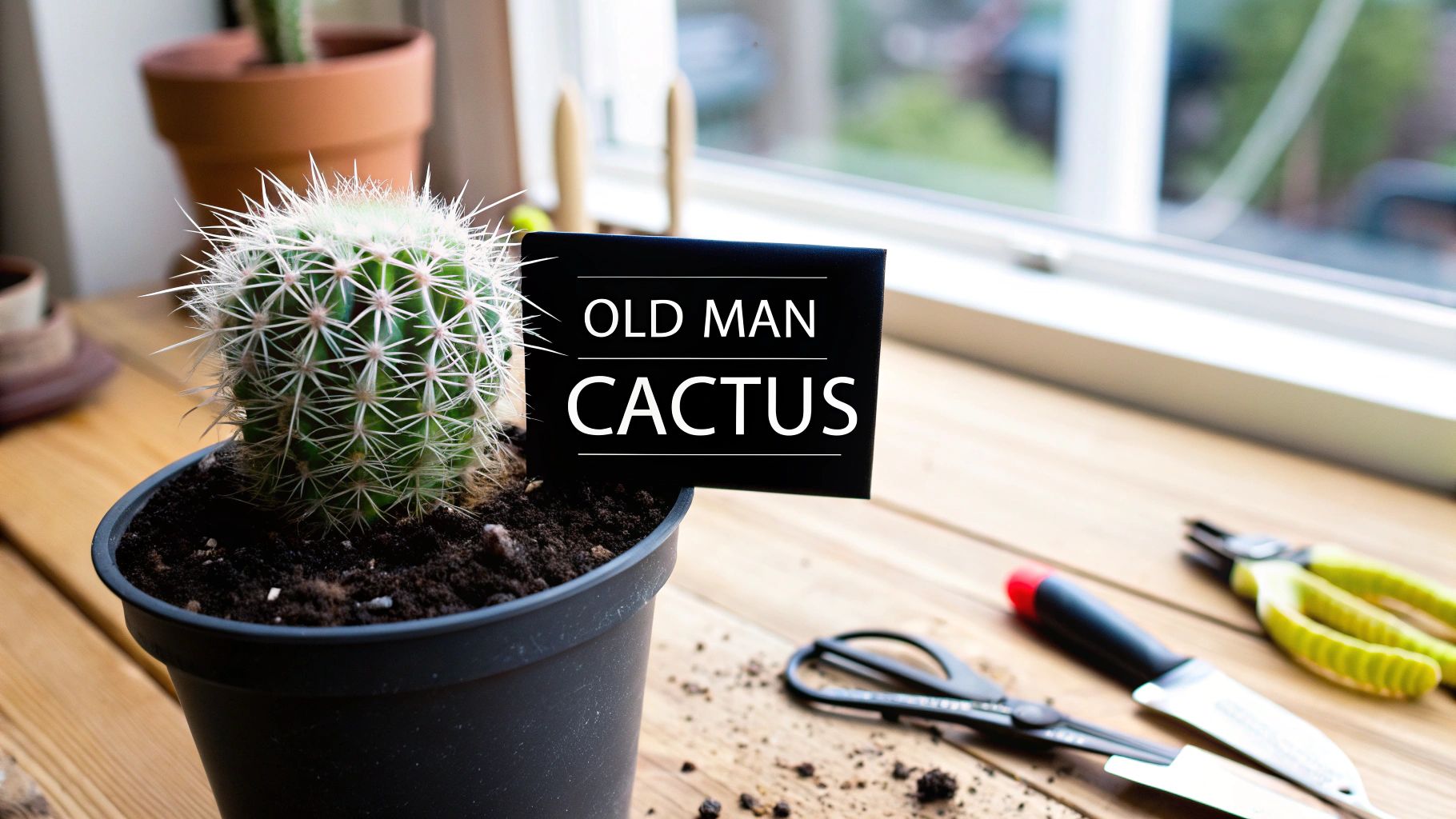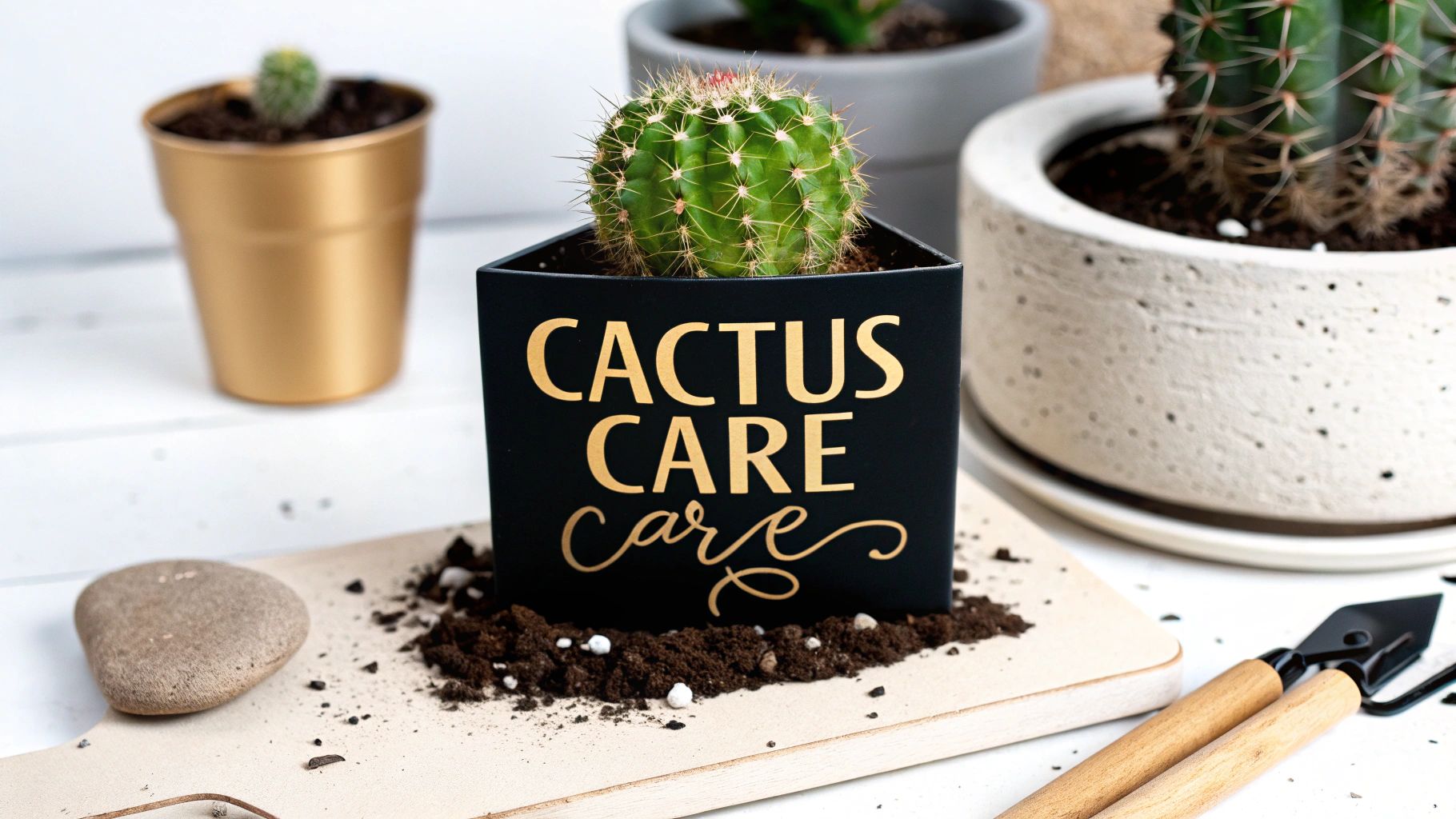It’s a common misconception that cacti don't need water, but nothing could be further from the truth. The reality is, they absolutely need water to live, but they are masters of making every drop last.
Think of a cactus less like a typical houseplant and more like a living canteen, perfectly engineered to store water through long, dry spells. Grasping this simple idea is the first real step to becoming a great cactus parent.
Why Your Cactus Is a Desert Survivor
The old myth that cacti thrive on total neglect is probably the biggest reason so many of them meet an untimely end. While they're incredibly tough, they can't live on air and good vibes alone. The trick is to understand their unique biology, which has been honed to perfection by some of the most unforgiving environments on the planet.
Unlike a thirsty fern that needs constant moisture, a cactus is built for a "feast or famine" water cycle—a heavy downpour followed by a long drought.
Every part of its structure is a marvel of water-saving engineering:
- Spines are Leaves: Those sharp spines aren't just for show. They're actually modified leaves that drastically reduce the surface area for water to evaporate from, while also protecting the plant from hungry critters.
- Waxy Skin: The thick, waxy skin you feel on a cactus stem acts like a waterproof seal, locking precious moisture inside.
- Shallow Roots: Cacti have widespread, shallow root systems that are designed to soak up any available water from a sudden rain shower before it disappears.
This amazing efficiency is how they survive where other plants wouldn't stand a chance. In fact, many cactus species can stay healthy and productive using just 20% of the water that a typical farm crop would need. This is largely thanks to a special type of photosynthesis that minimizes evaporation. You can dive deeper into these unique plant adaptations to see just how specialized they are.
The secret to a happy cactus isn’t about denying it water; it's about mimicking the rhythm of the desert. That means giving it a deep, thorough soak, and then letting the soil dry out completely before you even think about watering it again.
So, the real question isn't if your cactus needs water, but how and when it needs it. By learning to recreate their natural cycle of drench-and-dry, you'll give them exactly what they need to do more than just survive—you'll help them thrive.
How to Read the Signs Your Cactus Is Thirsty

Forget about sticking to a strict calendar. The absolute best way to know when to water your cactus is to learn how to read its signals. Cacti are surprisingly expressive plants; you just have to know what you’re looking for. When you learn their language, you can give them a drink exactly when they need it, avoiding the common disasters of overwatering or underwatering.
Think of a happy, well-watered cactus like a plump grape. It's firm, full, and has a vibrant color. A thirsty cactus, on the other hand, starts to look more like a raisin. The skin might pucker, develop fine wrinkles, or even feel a little soft when you gently touch it. This is a classic sign that its internal water stash is getting low.
Visual and Physical Cues of Thirst
Instead of just guessing, you can use these simple observational tricks to see if your plant is ready for a drink. These are some of the most reliable clues your cactus will give you.
- Wrinkled or Puckered Skin: Take a close look at the body of the cactus. If you see fine lines or a slightly shrunken look, especially near the base, it's thirsty. That once-taut skin gets a bit loose as the plant dips into its water reserves.
- Dull Color: A thirsty cactus often loses its bright, vibrant green. It might look a little lackluster or even take on a yellowish or reddish tint, which is a sign of stress from dehydration.
- The Weight Test: This one is surprisingly effective. A pot filled with bone-dry soil is a lot lighter than one with damp soil. Get a feel for how heavy your cactus is right after a good watering, and then feel it again when you know it's dry. Soon enough, you'll be able to tell it's thirsty just by lifting the pot.
Getting familiar with general plant health cues, like figuring out why leaves turn yellow, can make you an even better plant parent. It helps to know how to decode your plant's signals for all your green friends.
The Foolproof Soil Check
While the visual signs are great, the most definitive way to know if your cactus needs water is to check the soil. This direct method takes all the guesswork out of the equation.
The golden rule for cacti is simple: only water when the soil is completely dry. The easiest way to be sure is to just stick your finger in the pot.
Gently push your finger about one to two inches down into the soil. If you feel any moisture or coolness at all, it's not time to water yet. Wait a few more days. But if it feels dusty, crumbly, and totally dry, your cactus is officially ready for a drink. This one simple habit is your best defense against root rot, which is the number one killer of these plants. By learning these signs, you'll shift from a rigid schedule to a responsive routine that your cactus will thank you for.
The Best Way to Water Your Cactus

Figuring out when your cactus needs a drink is half the battle; knowing how to do it is the other. Many new cactus owners make the mistake of misting or giving their plants tiny sips of water. It feels right, but these methods are a recipe for disaster.
This kind of surface-level watering only encourages weak, shallow roots that can't properly anchor the plant. We want to avoid that.
The absolute best approach is what growers call the “soak and dry” method. It’s designed to imitate the way cacti get water in the wild: a rare but heavy desert downpour followed by a long dry spell. This cycle is exactly what a cactus needs to grow a deep, healthy root system.
Mastering the Soak and Dry Technique
Putting this method into practice is simple. Once you've checked that the soil is bone dry, it's time to bring the rain.
- Drench the Soil Thoroughly: I find it easiest to take the cactus to a sink or place it in a deep tray. Slowly pour water over the entire soil surface, letting it soak in. Keep going until you see water running freely out of the drainage holes.
- Let It Drain Completely: This step is crucial. Let the pot sit for a few minutes so all the extra water can escape. A cactus sitting in a puddle of water is the number one cause of root rot, so never let it stand in a water-filled saucer.
- Wait for It to Dry Out: Put your cactus back in its sunny spot and forget about it for a while. The "dry" part is just as important as the "soak." Don't even think about watering it again until the soil is completely dry from top to bottom.
This rhythm of a deep soak followed by a thorough dry-out is what your cactus is genetically programmed for. It lets the roots drink their fill and then allows them to breathe, preventing the fungal growth that leads to rot.
Watering Practices to Avoid
Some common watering habits seem intuitive but will ultimately harm your cactus. To keep your plant thriving, make sure you steer clear of these pitfalls:
- Misting: Cacti take up water through their roots, not their skin. Misting does almost nothing to hydrate the plant and can actually encourage fungal spots and rot to form on its flesh.
- Small Sips: Giving your cactus just a little bit of water only wets the top inch of soil. This tricks the plant into growing a weak, shallow root ball near the surface while the deeper roots wither away from thirst.
Of course, knowing how often to repeat this process is the next piece of the puzzle. For a deeper dive into timing, you can read our guide on how often you should water a cactus. By sticking with the soak and dry method, you'll be giving your desert survivor the perfect environment to flourish.
Spotting the Signs of an Overwatered Cactus

While letting a cactus get too thirsty can stress it out, giving it too much water is almost always a death sentence. It’s hands-down the most common mistake new owners make, and it can quickly turn a tough desert plant into a soggy, rotting mess.
Learning to recognize the early warning signs of overwatering is probably the most important skill you can have as a cactus parent. An overwatered cactus is a quiet emergency. Unlike a thirsty plant that just looks a bit wrinkled, a waterlogged one is actively dying from the inside out. All that extra moisture suffocates the roots, creating the perfect environment for fungus and the dreaded root rot.
Key Warning Signs You've Given Too Much Water
Catching the issue early is your best—and sometimes only—chance to save the plant. Keep a close eye out for these critical red flags. They often appear together as the problem gets worse.
- A Soft, Mushy Base: Gently squeeze the base of your cactus right at the soil line. It should feel firm and solid. If it’s soft, squishy, or feels wobbly, rot has probably already started.
- Yellow or Brown Color: Healthy cacti are a vibrant green. If your plant's skin starts turning yellow or brown, especially from the bottom up, that's a classic sign of too much water.
- Blisters or Scabs: Sometimes, you might see small, water-filled blisters or dark, corky spots on the cactus pads. This is called edema. It happens when the plant takes in water faster than it can use it, causing its cells to literally burst.
The most obvious clue, though, is the soil itself. If the soil is still damp days after you watered, feels heavy, or has a sour, swampy smell, you’ve got a serious problem. Healthy cactus soil should dry out completely between waterings.
Emergency Steps for a Soaked Cactus
If you see these signs, you have to act fast. Don't wait. The rot will only creep further up the plant. Think of this as a salvage operation, but one that can give your cactus a fighting chance.
- Unpot the Plant: Carefully slide the cactus out of its pot. The soil will probably be wet and clumpy.
- Check the Roots: Gently brush away as much of the old, soggy soil as you can. Healthy roots are white and firm. Rotted roots will be black, mushy, and might even smell bad or pull away easily.
- Trim Away All Rot: Using a clean, sharp knife or scissors, cut off every last bit of the black, rotted root. You have to be aggressive here—any rot you leave behind will just keep spreading.
- Let It Callus: If you had to remove a lot of roots, let the cactus sit out in a dry, shady spot for a few days. This gives the cuts time to dry and form a callus, which helps prevent new infections.
- Repot in Fresh Soil: Place your cactus in a new pot with fresh, completely dry, well-draining cactus mix. Do not water it right away. Seriously, wait at least a week before you even think about giving it a little drink.
This recovery process is a delicate one. For more in-depth tips, check out our complete guide on proper watering for cactus plants. Learning from a mistake like this is the best way to become a better cactus keeper for the long haul.
Tapping into the Rhythms of the Seasons
A cactus isn't a static houseplant; its needs change dramatically throughout the year. If you treat your watering schedule like it’s set in stone, you’re missing the most important cue the plant gives you: its natural rhythm of growth and dormancy. Learning to work with this cycle is what separates a cactus survivor from a cactus thriver.
Spring and summer are prime time for a cactus. Think of it as its "active season." The days are longer, the sun is stronger, and the plant is busy pushing out new growth—whether that's new pads, arms, or even getting ready to flower. Just like we need more energy when we’re active, your cactus is thirsty and needs more water to fuel all that work.
Then comes fall and winter, the "dormant season." The light fades, the days get shorter, and your cactus basically goes into a state of semi-hibernation. Its metabolism grinds to a near halt. It's not trying to grow; it’s simply resting and conserving resources. During this quiet period, its water needs plummet.
Spring and Summer: The Growing Season
This is when your cactus will be at its thirstiest, and when you’ll be watering most often. You'll want to stick to that "soak and dry" method we talked about, but you'll be doing it more frequently.
A good rule of thumb is to check the soil every two to four weeks. Of course, this depends on how much heat and sun it's getting and the size of its pot. The golden rule still applies: the soil must be bone dry all the way through before you even think about grabbing the watering can. It's surprisingly easy to overwater even in the heat of summer.
Fall and Winter: The Time for Rest
When the days get shorter and cooler, it’s time to pull back—way back. Watering your cactus on a summer schedule during its winter nap is the number one cause of root rot. The plant simply can't use that much water, so it just sits there in the cold, wet soil, and the roots begin to suffocate and decay.
In the dormant period, you need to cut your watering frequency drastically. For most indoor cacti, you might only water once every six to eight weeks, maybe even less. Your goal isn't to make it grow; it's just to give it a tiny sip to keep its roots from completely drying out.
In fact, some seasoned growers in very cold climates will stop watering their desert cacti entirely for a month or two in the dead of winter. The plant might look a little shriveled and dehydrated, but don't panic! This is a perfectly natural and healthy part of its cycle. By adapting to this seasonal ebb and flow, you're mimicking the desert environment your cactus was born to handle, setting it up for a long and healthy life.
How Your Cactus Environment Affects Watering
There’s no magic, one-size-fits-all watering schedule for cacti, simply because no two homes are exactly alike. The specific conditions in your space—from the light in your window to the type of pot you use—create a unique little world for your plant. Understanding this microclimate is the key to getting watering just right.
Think of it this way: your cactus's pot is its home. A classic terracotta pot is like a breezy house with the windows wide open. The porous clay breathes, allowing moisture to evaporate right through its walls. This means the soil dries out much faster, and you'll find yourself reaching for the watering can more often.
A plastic or glazed ceramic pot, on the other hand, is like a tightly sealed, insulated room. It holds onto moisture for a long time. With these, you have to be much more careful, stretching the time between waterings to avoid a soggy, waterlogged mess that can lead to root rot.
Light And Humidity's Major Role
Where you place your cactus has a massive impact on how thirsty it gets. A cactus soaking up the sun in a bright, south-facing window is working hard, photosynthesizing and losing water more quickly. That intense light and heat rev up its metabolism, making it much thirstier than a cactus sitting in a more subdued, lower-light corner.
The humidity in your home is another big piece of the puzzle. If you live in a dry climate or run a furnace all winter, the air will actively pull moisture from the soil. You'll need to water more frequently than someone whose cactus lives in a naturally more humid spot, like a bright bathroom.
Your goal is to become an expert observer of your cactus’s unique environment. Once you see how these factors play together, you can ditch the rigid schedule and give your plant water exactly when it needs it.
The Impact Of Soil And Potting Choices
Getting the foundation right is everything. The container and soil you choose directly control how well water drains away from the roots, which is the most critical factor in preventing rot.
- Pot Material: Terracotta is a fantastic choice, especially for beginners. Its porous nature provides a great safety net against overwatering.
- Soil Mix: Never use standard potting soil. It's designed to hold water, which is the opposite of what a cactus needs. You need a gritty, fast-draining mix. We break down how to create the perfect blend in our guide to cactus and succulent soil.
- Light Exposure: A cactus in a sunny spot might need water twice as often as the exact same plant in a dimmer location.
- Room Humidity: A cactus in a dry, centrally heated room will dry out far quicker than one in a more humid space like a kitchen.
The right combination of these elements creates a healthy, stable environment where your cactus can thrive.
How Environmental Factors Affect Watering Frequency
To put it all together, here’s a quick-reference table showing how different variables push your watering frequency in one direction or the other.
| Factor | Increases Water Need | Decreases Water Need |
|---|---|---|
| Light | Bright, direct sunlight (e.g., south-facing window) | Low or indirect light (e.g., north-facing window) |
| Pot Type | Porous materials like unglazed terracotta or clay | Non-porous materials like plastic or glazed ceramic |
| Humidity | Low humidity, dry air (e.g., heated rooms) | High humidity (e.g., bathroom, humid climate) |
| Airflow | Good air circulation from a fan or open window | Stagnant, still air |
| Temperature | Warm to hot indoor temperatures | Cool indoor temperatures |
| Pot Size | Small pot that dries out quickly | Large pot with more soil volume |
Think of these factors as a checklist. The more items you have in the "Increases Water Need" column, the more often you'll need to check your plant's soil.
As this infographic shows, these needs also change dramatically with the seasons. Your cactus isn't growing much in the fall and winter, so its water needs drop significantly.

This seasonal shift is crucial. As the days get shorter and cooler, you must cut back on watering to mimic the plant's natural dormant cycle and prevent issues when it's not actively growing.
Got More Cactus Questions? We've Got Answers
Even after you've got the basics down, a few tricky situations always seem to pop up. Let's run through some of the most common questions I hear from fellow cactus lovers. Getting these right will help you handle those little "what-if" moments like a pro.
One of the biggest questions is about tap water. Is it safe? For the most part, yes. Most cacti are perfectly happy with regular tap water. The only time you might run into trouble is if you have very hard water, which is loaded with minerals. Over time, you might see a white, crusty buildup on the soil or the pot. If that happens, switching to filtered, distilled, or even rainwater is a great idea.
Newly Potted Cacti and Other Concerns
So, what do you do with a cactus you just repotted? This is a really important one. You absolutely want to wait at least a week before watering it. Repotting can be a little rough on the roots, and giving them that week-long dry spell allows any minor scrapes or breaks to heal over. Watering too soon is a fast track to root rot.
Do cacti really need water to survive? Yes, they do. Their ability to store water is legendary, and they can certainly go months without a drink, but they can't live on their reserves forever. Without water, they'll eventually shrivel and give up.
Here are a few more quick answers to some common head-scratchers:
- Should I add fertilizer when I water? Only during the growing season in spring and summer. A diluted, cactus-specific fertilizer once a month is plenty.
- What if I'm going on vacation? Don't worry about it! Your cactus will be just fine. It's far better to leave it dry for a few weeks than to risk a well-meaning friend or neighbor watering it too much.
For anyone who's truly caught the plant bug and wants to go deeper than just cacti, exploring comprehensive horticulture studies can be a fantastic next step. It’s a great way to build a serious foundation in overall plant care.
Ready to find the perfect desert plant for your home? At The Cactus Outlet, we offer a huge selection of healthy, beautiful cacti ready to ship directly to you. Explore our collection and start your journey today at https://www.cactusoutlet.com.




